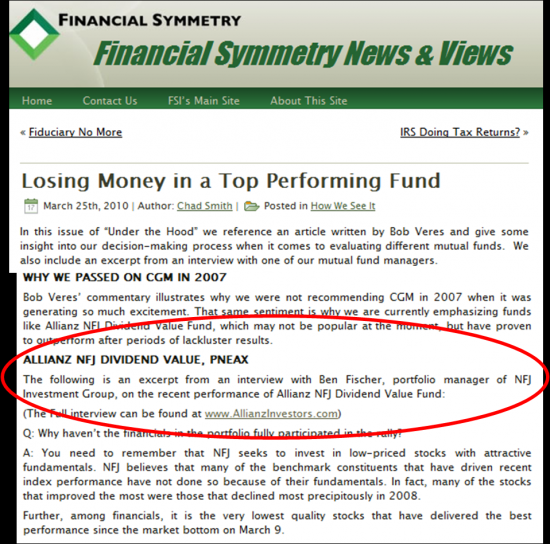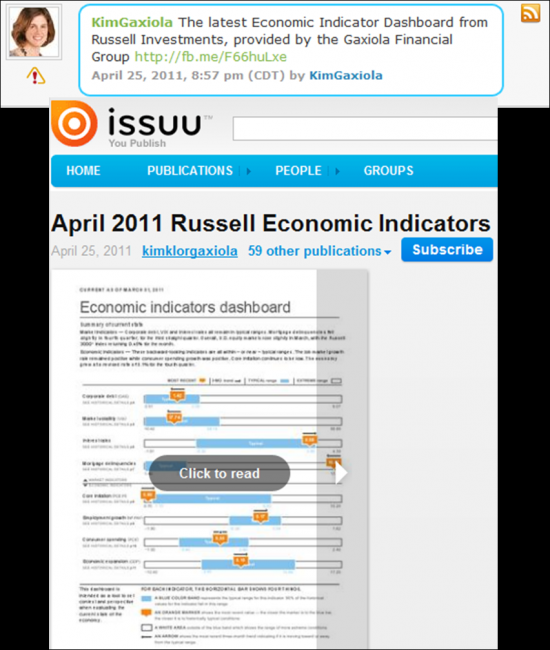10 Examples Of Mutual Fund, ETF Content In The Wild
/ TweetAcross the industry, there are plenty of signs that mutual fund and exchange-traded fund (ETF) marketers are increasingly packing up their content to go.
Social media represents all kinds of threats to the status quo of investment management marketing, but content syndication as a concept is not one of them. For years, money managers have made their strategists available for media appearances, bylined articles for others, and sponsored and distributed research findings. I throw my gentle jabs at those of you whose sites are largely archives of Adobe Acrobat files but even content distribution via .pdf is a form of syndication.
So, really, asset manager exploration today of social sites like YouTube, SlideShare, LinkedIn and Facebook for broader distribution of content is just an extension of something this industry already understands on one level.
Flipping The Perspective
But all of that is the supply side. What do you know about the demand for the content that you are syndicating—or to quote an inelegant expression favored by a former colleague: “Are the dogs in fact eating the dog food?”
We continue to see low view totals on the videos and presentations uploaded to social sites and those numbers reflect all activity, not just advisor views. But consumption is just one measure. The higher test is usage. Is the content you’re syndicating useful to the professionals you rely on to represent your investment products?
The following is a homemade gallery culled from examples we collect online daily—what we've found in the wild, if you will. Each example below shows an advisor’s embrace of a piece of asset manager content.
A Few Qualifiers
First, a few qualifiers:
- These are snapshots of content that's valued and shared by advisors whose online activities we can observe and learn from. Asset manager content relied upon and distributed by advisors offline can't be captured in the same way, and the majority of advisors are offline, obviously. This is just a glimpse of content as a share-able object. It's not about the essential value of the content you're creating.
- This collection has a Twitter skew, attributable to our continual monitoring of the tweets on AdvisorTweets.com. However, the advisors’ tweets provide a view into their other social media activity including their blogging.
- Where a tweet is involved, you’ll see a screenshot of the tweet on top of an excerpt of the content the tweet linked to. In some instances, you can see the asset manager named; in others, I consulted the AdvisorTweets database of 68,000 links exchanged over the last 12 months to find shortened URLs that resolved to one of your sites.
- These are representative. By that I mean that there are other advisor tweets or online references to asset manager content. These aren’t all there are. But I haven’t seen hundreds of others, not even dozens of others. The dog food is not attracting packs of (social) dogs just yet.
Should we expect to see more asset manager content being shared? Or, is there an issue here? Is it the content that's being made available? Is it the marketing and promotion of the availability of the content? Or is it unrealistic to expect advisors to make a habit of publicly citing asset manager content while building their own brands? Is it just early?
Yes is the answer to all those questions, I think. Your content vies for the attention of advisors on social sites along with an infinite supply of awesome online content created by armies of Compliance-free content producers whose work is promoted in imaginative ways.
It is early. But…to be truly effective at content syndication, you may need to up all elements of the game you have played well for so long. I encourage you to learn what you can from the content that is being commented on and shared. Make sure your analytics and social monitoring are in place and, as I allude to in a few examples below, trace the links to your site. There's a chance that your Website page-building is undoing your best efforts.
As has been dawning on all brands, you have no control over how your content will be used or referred to. Ever the more reason to control what you can. That includes anticipating and planning for content interactions.
Finally, check in regularly on AdvisorTweets.com to deepen your understanding of the content that advisors respond to. Use the search capability to find advisors’ references to your content.
1. JP Morgan Market Commentary Merits Mention
Score! A blog post by influential advisor Harold Evensky cites and quotes a JP Morgan commentary. Unfortunately, there's no link to the JP Morgan site.

2. This Chart From First Trust Is A Direct Hit
This is a textbook example of how a tweet can drive traffic to your site, or in this case to First Trust’s site.
On the upside: the tweet referred to a chart and the URL took a visitor directly to the chart. When the content being referred to isn't able to be found immediately by someone clicking through the tweet, it's a lost opportunity as you'll see in a few instances below. The problem may be borne of an inflexible content management system or poor content planning (i.e., too much content on one page can be distracting).
On the downside: that is one long URL that the advisor didn’t shorten. Good thing he enabled his Twitter application to send a long update.

3. A Whitepaper From American Century
Yes, you and Compliance sweat over the headlines you publish. We show an innocuous example here but count on your work being shortened, paraphrased and even spinned to support a point of view. Because this advisor didn’t cite American Century’s Twitter account, American Century would have needed to have monitoring in place in order to catch this mention. (Given American Century's careful study of Twitter, I'm betting they did.)

4. Lord Abbett-Enabled Sharing
By offering the social sharing icons on its advisor site, Lord Abbett enabled the sharing of this content—note the @addthis in the tweet.

5. DFA’s Popular Video
If you held my feet to the fire and forced me to point to the most tweeted-about piece of asset manager content in the last year, I’d have to guess that it was a Dimensional Fund Advisors video published in March. This reflects the heavy RIA bias of advisors on Twitter today, RIAs' use of DFA and, as you’ll see below, the content is good.

6. Evidence That Allianz Shareholder Reports Get Read
Social media “conversations” get pretty interesting when advisors use their blogs to shed light on their investment selection process. This screenshot combines two snippets from CFP Chad Smith's blog in which he excerpts from an Allianz portfolio manager Q&A. Unfortunately, his link to the Allianz site isn’t a direct link to the interview itself. Traffic from this mention will likely dead-end at the Allianz home page.

7. An Oldie But Goodie Vanguard Podcast
99.9% of the time advisors seek to share the freshest content but here's an exception to the role—this tweet promotes a podcast from 2009.
Note that the tweet retains the Vanguard-customized shortened URL (vgi.vg). That probably means that the advisor saw a recent Vanguard tweet on this and then wrote his own. His retention of the Vanguard URL is good Twitter etiquette because it helps Vanguard tracking. Nice.
But let this example serve as a reminder of the importance of keeping all navigable site content in shipshape. Out-of-date content is always a risk. It can be exacerbated by users landing on your content intent to share some of it.

8. A U.S. Global Investors Advisor Alert
Here’s another case of an advisor linking to public content that’s labeled as an advisor alert. Also, notice the social sharing support again from AddThis. Unfortunately, the advisor linked to a page that is evidently updated with the freshest alert content.
How would someone looking for the October 22, 2010, content find it today? The trail has gone cold. Also, I wish this advisor had referred to US Global Investors' @USFunds Twitter account in the tweet.

9. Russell’s Document Uploaded To 1 Social Site, Promoted On Another
A two-syndication play: For the last several months, this especially social media-savvy advisor has been regularly uploading Russell Investments’ Economic Indicators Dashboard document to the publication sharing site Issuu.com. Once uploaded, she tweets about it.

10. Tweet Flies After Advisor Spots GMO Content In Scribd On Another Site
Who’s to say whether this advisor would have come across this GMO quarterly letter if it hadn’t been uploaded to Scribd and then embedded in a FundMyMutualFund.com Web page? We may never know. Because he did, he saw it, liked it and then tweeted about the brilliance of the analysis.




